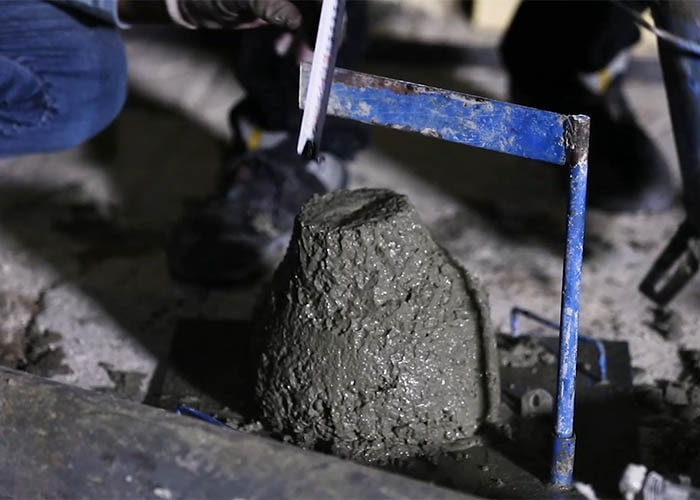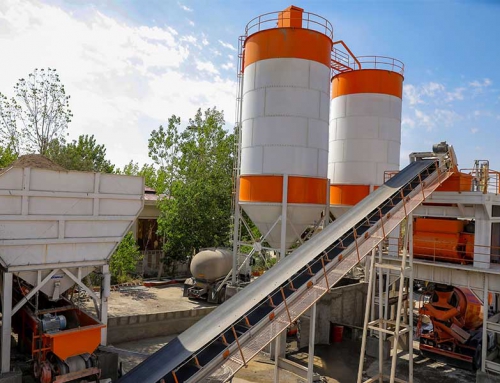Concrete Slump Test
The concrete slump test is conducted to determine the workability or consistency of the concrete mixture provided in the laboratory or in the field. In other words, a concrete slump test is conducted to investigate the uniform quality during the construction of the structure. The slump should be called the simplest concrete workability test; it is low-cost and provides immediate results.
In general, the numerical value of concrete slump is used to find the workability, which indicates the proportion of water to cement but various factors such as materials’ properties, mix methods, usage amount, additives, and others affect concrete slump. To understand better the nature of a concrete slump test and the way it should be done, follow another article from Pars Zagros.
What is the slump test?
Fresh concrete which is cast in the project field soon, should have special standards as a part of the building project before use. The concrete slump test measures the consistency of a concrete volume to observe how the concrete easily flows in the mold and between rebars.
This test not only determines consistency between different classes of concrete but also detects faults existing in the mixture and enables the operator to modify it before casting the mixture in the field. By measuring the general concrete slump, you can recognize if the portion of water to cement is too large or not and if the mixture has high workability or not!
The importance of using concrete slump test
The main reason to conduct concrete slump tests is to make sure about the quality and strength of similar concrete classes. The more water is added to the mixture, the weaker the concrete will become. If the project needs greater workability and more consistent concrete (as a result of a greater slump), we should increase the cement content to ensure that the concrete can still provide the desired compressive strength. This test is only one of the ways of making sure about the concrete quality.
What is concrete workability?
Workability is a crucial property of concrete and is related to compression and strength. Desirable workability is not the same for all kinds of concrete. Therefore, we can not set a specific standard for all the work related to concrete pouring.
Some definitions of workability are given below:
- “Workability can be defined as the amount of beneficial internal work required to achieve full compression.”
- “Workability indicates the required effort to manipulate the amount of freshly mixed concrete with minimal loss of concrete homogeneity”
- “Workability is a property of fresh concrete that determines the ease of its mixing, pouring, integrating, and completing.”
The advantages of concrete slump test
- Slump test is so easy and simple: a non-technical person can conduct this test in the fastest time without any problem.
- The test can be conducted at any time: Investigating workability with slump test of different concrete classes for various building elements such as columns, beams, foundations, etc. is possible at any time.
- This test does not need expensive equipment: It is not necessary to send the specimen to the laboratory. This test can be conducted in the field with only a few inexpensive tools.
- The result of the slump test can be prepared very quickly: In the compressive strength test, it takes almost one month to get to a result but with the concrete slump test, the slump value can be measured in only a few minutes.
The limitations of concrete slump test
- It is not reliable for lean concrete: In lean concrete, a true slump can change to shear or easily collapse. Great variations can be found in a covering concrete mix specimen which can be confusing in determining the exact result.
- Measurement is not exact: Because slum has no unique relationship with workability. Even the same slump can be recorded for different types of aggregates. Also, we should consider that slump does not measure ease of compression. This test only occurs under the weight of the concrete itself and this test does not show the behavior in different conditions like vibrating, finishing, pumping, or moving by vibration.
- Can not differ between the workability of hard mixes: Because it presents the drop to be zero. In a dry zone, there is no difference distinguishable between various mixes with different workability.
- It is not suitable for concretes consisting of aggregates greater than 40 mm.
Factors effective on concrete slump test
- Chemical properties of materials, fineness, particle size distribution, moisture content and temperature of cement materials, size, texture, gradation, cleanliness, and moisture content of aggregates.
- Chemical additives (type, combination, interaction, sequence of addition and their effectiveness)
- Air content of concrete
- Methods and equipment for batching, mixing, and concrete transportation
- Concrete temperature
- Sampling of concrete, drop test technique, and condition of test equipment
- The amount of free water in concrete
- Concrete mixing time during the test

The required equipment for conducting concrete slump test
Tools required to conduct slump test are as follows:
- Frustum mold of slump with the height of 300 mm, bottom diameter of 200 mm, and top diameter of 100 mm
- Tamper rod with a diameter of 16 mm and a length of 600 mm (one end of it is circular)
- A metal tray with 40×40 or 50×50 dimensions
- Measuring scale (height measurement)
- Trowel/float
- Shovel

-
Concrete slump test methodology
- Clean and oil the inner surface of the cone mold.
- Put the cone mold on the flat metal tray.
- Fill the cone mold with the prepared concrete mix in three of four almost equal layers with a shovel.
- Apply each layer evenly on the cross-section of the mold with 25 impacts of the round end of the tamping rod.
- Remove the excess of concrete on the cone mold and level its surface with a trowel.
- Clean the mortar of water leaked between the mold and the base plate.
- Bring up the cone mold of concrete immediately and gradually.
- Measure the slump as the difference between the height of the cone mold and the concrete drop value, to get the slump number.
Note: The above operation should be conducted in a place free from vibration or impact and within 2 minutes after sampling.
The results of the concrete slump test
An increase in slump means that the moisture content of aggregates has increased unexpectedly or the lack of fine aggregate (sand) has changed. Too high or too low slumps indicate inappropriate workability of concrete and alert the mixer operator to find a solution for the problem.
The measured slump (vertical drop) should record the drop of the specimen in mm during the test. Investigating the concrete slump shape is as described below:

- True Slump: True slump is the only slump that can be measured during the test. Measuring between the top section of the cone and the top of the concrete is conducted after removing the cone. In this slump, the concrete falls from the sides.
- Zero Slump: A zero slump indicates the very low water-to-cement portion that leads to dry mixes. This type of concrete has low workability and is generally used for road construction.
- Collapsed Slump: This slump indicates that the water-to-cement portion is too high, meaning that the concrete mix was too moistened or the mix has high workability and its slump test is not suitable.
- Shear Slump: Shear slump indicates that the result is imperfect and the concrete should be tested again.
The required precautions during the concrete slump test
To achieve a suitable result, some precautions should be considered during the test:
- Before any test, the inside of the mold and the base should be moistened. It is necessary to reduce surface friction.
- Before lifting the mold, the area around the base of the cone should be cleaned of any accidentally poured concrete.
- The mold and the base plate should be non-porous.
- This test should be conducted in a place free from vibration or impact.
- The concrete specimen should be so fresh, a delay should be avoided and the test should be conducted right after the mix.
Measuring workability using concrete slump test
If a shear or collapse drop occurs, the test should be repeated. We can conclude from the only true slump and categorize the result in a range according to the slump value:
- Too low workability: drop between zero to 25 mm or zero to 1 inch
- Low workability: record value of 25 to 50 mm or 1 to 2 inches
- Medium workability: drop between 50 to 100 mm or 2 to 4 inches
- High workability: record value of 100 to 175 mm or 4 to 7 inches
Although there are different types of categorizations for concrete, the main rule is that a low slump value indicates lower workability and a high slump value indicates high workability.
Iran’s code standards for concrete slump test
According to Issue 55 of general technical specifications for building works, suitable slump for concrete elements and blocks is based on the following table:
International standards for concrete slump test
Various international regulations have specific standards for concrete slump tests. These standards can specify methods and equipment for determining the consistency of fresh concrete using slump. Strict adherence to these standards during slump tests is essential for acceptance and reliability.
The standards of this test are as follows:
- American Society for Testing and Materials (ASTM): ASTM economic testing standards include ASTM C 143, ASTM C143M
- American Association of Highway and Transportation Officials (AASHTO): AASHTO economic slump test standards include AASHTO T119, AASHTO BS1881
- British and European standard: BS EN 12350-2 British and European slump test standard
- Indian standard: IS 1199 – 1959
Which items should be declared in the concrete slump test report?
In workshop report, following items should be declared in concrete slump test:
- Identity card of the tested specimen
- Location of the test
- Date of the test
- Type of slump (true, zero, collapse or shear)
- Slump value (with 10 mm error)
- Any deviation from the national standard of Iran No. 2-3203 of year 1387 (2007)
- Temperature of the concrete specimen during test
- Time of the test
Conclusion
The concrete slump test presents the consistency and flow of the fresh concrete mixture. For each building project, it is important to test slump value. This topic is also effective on ultimate compressive strength of concrete and other factors such as crack rate, durability, etc.










Leave A Comment